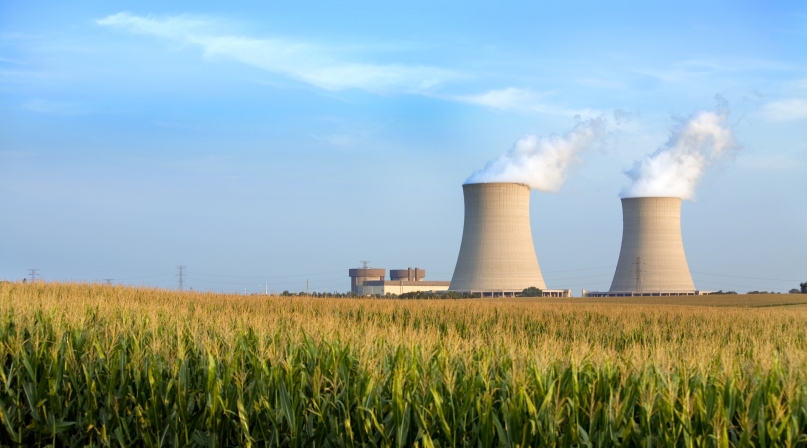White House signs executive orders to advance nuclear power
Author

Charlotte Mitchell Duyshart

Rachel Yeung
Upcoming Events
Related News

Key Takeaways
On May 23, President Trump signed four executive orders (EOs) focused on expanding the nuclear energy industry. The executive orders aim to position nuclear power as a key contributor to energy reliability, economic growth and national security — especially as artificial intelligence, advanced manufacturing and military operations increase demand for stable, high-density power sources.
What’s in the executive orders?
Ordering the Reform of the Nuclear Regulatory Commission (NRC)
This EO aims to restructure the NRC and streamline the process for licensing new nuclear reactors to expand deployment nationwide.
- Sets a national goal to expand nuclear energy capacity from 100 to 400 gigawatts by 2050
- Instructs the NRC to reorganize its structure—reducing staff where appropriate (especially within the Advisory Committee on Reactor Safeguards) and potentially expanding teams that handle new reactor licensing
- Requires the Nuclear Regulatory Commission (NRC) to update its licensing rules, including an 18-month deadline to approve new reactor projects and a streamlined process for reviewing microreactors and modular reactors
- Directs the NRC to consider economic and national security benefits of nuclear energy alongside safety, health and environmental factors
Reinvigorating the Nuclear Industrial Base
This EO focuses on rebuilding domestic nuclear infrastructure and supply chains.
- Sets targets to increase output at existing nuclear plants by 5 GW and begin construction on 10 new large reactors by 2030, while prioritizing federal funding to support the nuclear industry
- Calls for a review of national policy on handling used nuclear fuel, including options for recycling and reuse
- Starts planning to expand uranium processing and enrichment in the U.S. to supply reactor fuel
- Aims to grow the nuclear workforce by expanding training, apprenticeships, and student access to national labs
Reforming Nuclear Reactor Testing at the Department of Energy (DOE)
This EO clarifies the DOE’s authority over certain non-commercial test reactors and aims to streamline their deployment.
- Directs the Department of Energy (DOE) to launch a pilot program to build and operate at least three test reactors outside the National Laboratories, with a goal of starting operations by July 4, 2026
- Clarifies that certain non-commercial advanced reactors controlled by DOE are for research and fall under DOE’s authority
- Calls for updates to DOE rules to speed up approvals, including streamlining or skipping some environmental reviews
Deploying Advanced Nuclear Reactor Technologies for National Security
This EO seeks to link nuclear energy development to military readiness, national defense and international competitiveness.
- Launches a program to install nuclear reactors on military bases within the next three years
- Instructs DOE to support powering AI data centers with nuclear energy and to label those sites as critical defense infrastructure
- Provides 20 metric tons of specialized nuclear fuel (HALEU) for private projects powering AI facilities on DOE sites
- Develops a strategy to strengthen international partnerships and expand U.S. nuclear exports
County Impacts
NACo supports the advancement of nuclear and other alternative energy sources as part of a comprehensive national energy strategy. Counties play a key role in how federal energy policy is implemented—especially when it comes to the siting of energy projects that impact local communities and advising opportunities to revitalize underused land.
Counties also support commonsense permitting reforms that include meaningful engagement with federal and state partners. As the federal government expands its nuclear energy efforts, counties continue to advocate for clear guidance and a seat at the table to ensure local voices are included in decisions around siting, permitting and regulation of nuclear facilities to ensure responsible energy deployment.
Advocacy
White House signs executive orders to boost coal industry
On April 8, President Trump signed four executive orders (EOs) focused on the U.S. coal industry, aligning with the Administration’s “Unleashing American Energy” EO signed in January 2025.

Related News
‘Fix-It Fair’ brings new life to damaged items, helps divert waste
Thurston County, Wash. partnered with a non-profit, whose members volunteer to fix things that were difficult to recycle.

U.S. House of Representatives passes SPEED Act and other permitting reform bills
On December 18, the U.S. House of Representatives passed the SPEED Act (H.R. 4776). The SPEED Act would strengthen county involvement in decision-making and make needed commonsense reforms to the federal environmental review process.

House Natural Resources Committee advances the Endangered Species Act Amendments Act of 2025
On December 17, the House Natural Resources Committee advanced the Endangered Species Act (ESA) Amendments Act of 2025 (H.R. 1897). The version passed by the committee adopted several changes from the initial bill and would address key county concerns by improving the implementation of the ESA. The legislation now awaits a floor vote before the whole U.S. House of Representatives.